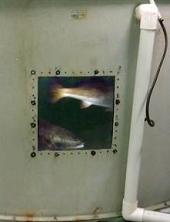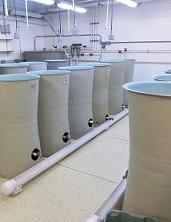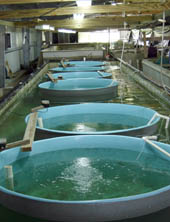The Fisheries and Mariculture Laboratory (FAML) has a large and diverse array of facilities and equipment to support our research in mariculture, physiology, ecology, and fisheries. FAML is situated on 10 acres of land adjacent to the channel that connects the Gulf of Mexico with Redfish Bay and Corpus Christi Bay. The channel provides a reliable supply of high quality seawater for use throughout our facility.
FAML's fish-keeping facilities are almost entirely recirculating systems that minimize the need to discharge effluent into the local environment. To achieve this, all of our large tanks have separate biological filters to maintain water quality. Recirculating systems also protect our research from variations in salinity and occasional toxic red tides that can occur in local waters.
We maintain 17 broodstock tanks that range in size from 10 to 23 feet in diameter and 6 raceways that are 8 feet wide and either 20 or 45 feet long. We also have a large capacity of highly replicated larval rearing experiments. We have two larval rearing laboratories, each with a capacity of at least 18 tanks. Two environmental chambers located within one of the larval rearing laboratories provides space for laboratory experiments on fish larvae under controlled conditions without the need to move larvae far from where they are maintained. We also have limited facilities for grow-out juvenile fishes.
The CCA Texas Laboratory for Marine Larviculture is specially designed facility for research on larval rearing. This 3,000 square foot building contains two seawater labs, each with three tanks that hold 1,500 gallons that can be divided into as many as 36 replicate tanks. The labs are connected by a live food preparation area where algae, rotifers, and Artemia are cultured. Another connector provides office space for researchers.
FAML is well equipped for a variety of laboratory analyses, ranging from molecular physiology to respirometry, growth, and motion analysis. Biochemical and physiological analyses make use of onsite high performance liquid chromatograpy (HPLC), gas chromatography, microplate spectrophotometry, a freeze dryer, and thermocyclers for quantitative real time polymerase chain reaction (PCR and qPCR. Microscopy capabilities include confocal and light microscopy, cryostat, and microtomes for histology.











